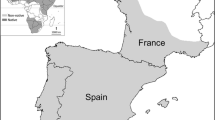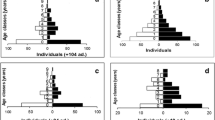Abstract
To analyse the population structure and reproductive biology of the Iberian hareLepus granatensis Rosenhauer, 1856, 498 hares (264 males and 234 females) were collected in monthly samples from October 1998 to September 1999. Females reached larger sizes than males, with approximately 400 g difference in body mass on reaching sexual maturity. The total sex ratio was 1∶1, with a bias in favour of males in winter. Sexually active males and females appeared in every month but August, when no sexually active female was found. Births occurred in every month and were more frequent between March and July. Seasonal variation in kidney fat index (KFI) followed a similar pattern in males and females, with an increase in mid-autumn and a decline at the end of winter. Reproductive activity appeared in every month, with a maximum from February to June. Reproductively hyperactive females (simultaneously pregnant and nursing) appeared in every month except in January, with a first peak in March and a second lower peak in May–June. Litter size fluctuated between 1 and 7 leverets. The most frequent gestations involved 1 or 2 foetuses. The mean annual litter size was 2.08 and the average number of litters per productive female per year was estimated to be 3.48. The maximum productivity was recorded between March and May. The total annual production of young per adult female was estimated to be 7.21. The minimum annual survival rate of young was 27.91%. On the basis of these results we propose to maintain the limit of the hunting period between October and December. We discuss the relationship between the low young/adult ratio obtained and the hunting method used.
Similar content being viewed by others
References
Abildgård F., Andersen J. and Barndorff-Nielsen O. 1972. The hare population (Lepus europaeus Pallas) of Illumø Island, Denmark. A report on analysis of data from 1957–1970. Dannish Review of Game Biology 6(5): 1–32.
Angerbjörn A. and Flux J. 1995.Lepus timidus. Mammalian species 495: 1–11.
Alves P. C., Gonçalves H., Santos M. and Rocha A. 2002. Reproductive biology of the Iberian hare,Lepus granatensis, in Portugal. Mammalian Biology 67: 258–371.
Amaya J. N., Alsina M. G. and Brandani A. A. 1979. Ecología de la liebre europeaLepus europaeus P. Parte 2. Reproducción y peso corporal de una población del área de San Carlos de Bariloche. Ecología y Control de la Fauna Silvestre. Technical Report no. 9.
Batista T. and Carvalho de Cruz E. 1996. [Dynamics of a hare population]. Revista Florestal 9: 175–188. [In Portuguese]
Batista T. and Meixa de Almeida L. 1996. [Results of measurements and other observations in hares taken from contests and hunting from 1992 to 1995]. Revista Florestal 9: 123–135. [In Portuguese]
Blottner S., Faber D. and Roelants H. 2000. Seasonal variation of testicular activity in European brown hareLepus europaeus. Acta Theriologica 45: 385–394.
Bonhomme F., Fernández J., Palacios F., Catalan L. and Machordon A. 1986. Caractérisation biochimique du comples d’espéces du genreLepus en Espagne. Mammalia 50: 495–506.
Bonino N. and Montenegro A. 1997. Reproduction of the European hare in Patagonia, Argentina. Acta Theriologica 42: 47–54.
Broekhuizen S. and Maaskamp F. 1981. Annual production of young in European hare (Lepus europaeus) in the Netherlands. Journal of Zoology, London 193: 499–516.
Broekhuizen S. and de Wit J. 1972. [A case of extrauterine pregnancy in European hare (Lepus europaeus)]. Nederland Jager 77: 619. [In Dutch]
Bronson F. H. 1958. Notes on body size of black-tailed jack rabbits. Transactions of the Kansas of the Academic of Science 61: 109.
Calzada E. and de la Martínez F. J. 1994. Requerimientos y selección de hábitat de la liebre mediterránea (Lepus granatensis) en un paisaje agrícola mesetario. Ecología 8: 381–394.
Carro F., Beltrán J. F., Pérez J. M., Márquez F. J., Iborra O. and Soriguer R. C. 1999. Dinámica poblacional de la liebre ibérica (Lepus granatensis) en el Parque Nacional de Doñana. Resúmenes IV Jornadas SECEM, Segovia: 1–20.
Duarte J. and Vargas J. M. 1998. La perdrix rouge et le liévre ibérique dans les oliveraies du sud de l’Espagne. Perspectives de gestion de ce type d’habitat. Bulletin Mensuel de l’Office National de la Chasse 236: 14–23.
Duarte J., Vargas J. M. and Farfán M. A. 2002. Biología de la liebre ibérica (Lepus granatensis). Bases técnicas para la gestión cinegética. [In: Aportaciones a la gestión sostenible de la caza. A. Lucio and M. Sáenz de Buruaga, eds]. FEDENCA — Federación Española de Caza: 29–59.
Flux J. E. C. 1962. The ecology of the Scottish mountain hareLepus timidus scoticus Hilzheimer. PhD thesis, University of Aberdeen, Aberdeen: 1–209.
Flux J. E. C. 1965. Timing of the breeding season in the hare,Lepus europaeus Pallas, and rabbit,Oryctolagus cuniculus L. Mammalia 29: 557–562.
Flux J. E. C. 1967. Reproduction and body weights of the hareLepus europaeus Pallas, in New Zealand. New Zealand Journal of Science 10: 357–401.
Flux J. E. C. 1970. Life history of the mountain hare (Lepus timidus) in north-east Scotland. Journal of Zoology, London 161: 75–123.
Flux J. E. C. 1971. Validity of the kidney fat index for estimating the condition of hares: a discussion. New Zealand Journal of Science 14: 238–244.
Frylestam B. 1979. Structure, size and dynamics of three European hare populations in Southern Sweden. Acta Theriologica 24: 449–464.
Frylestam B. 1980a. Growth and body weight of European hares in southern Sweden. Holarctic Ecology 3: 81–86.
Frylestam B. 1980b. Reproduction in the European hare in southern Sweden. Holarctic Ecology 3: 74–80.
Gosalbez J., López-Fuster M. J. and Durfort M. 1979. Ein neues Färbungs-verfahren für Hodenzellen von Kleinsäugetieren. Säugetierkunde Mitteilungen 27: 303–305.
Hansen K. 1992. Reproduction in European hare in a Danish farmland. Acta Theriologica 37: 27–40.
Hediger H. 1948. Die Zucht des Feldhasen (Lepus europaeus Pallas) in Gefangenschaft. Physiology Compared 1: 46–62.
Hewson R. and Taylor M. 1975. Embryo counts and length of the breeding season in European hares in Scotland from 1960–1972. Acta Theriologica 20: 247–254.
Iason G. 1990. The effects of size, age and cost of early breeding on reproduction in females mountain hares. Holartic Ecology 13: 81–89.
Jacob A. 1956. Häsin mit 9 Junghasen. Deutsche Jäger 73: 458.
Jacobs W. 1966. Nachgewiesene Superfotation beim Feldhasen (Lepus europaeus). Zeitschrift für Jagdwissenschaft 12: 138.
Keith L. B. 1981. Population dynamics of hares. [In: Proceedings of the World Lagomorph Conference, Guelph, Ontario, August 1979. K. Myers and C. D. MacInnes, eds]. University of Guelph, Guelph, Ontario: 395–440.
Lazo A., de le Court C. and Soriguer R. C. 1992. Evaluation of hare abundance allowed by their use of attraction point. Zeitshrift für Säugetierkunde 7: 373–379.
Lechleitner R. R. 1959. Sex-ratio, age classes and reproduction of the black-tailed jack rabbit. Journal of Mammalogy 40: 63–81.
Lincoln G. 1974. Reproduction and “March madness” in the brown hare,Lepus europaeus. Journal of Zoology, London 174: 1–14.
López J. M., Hernández A., Purroy F. and Robles J. L. 1996. Datos sobre la biología de la reproducción de la liebre ibérica (Lepus granatensis Rosenhauer, 1856) en agrosistemas cerealistas de la provincia de León (NW de España). Revista Florestal 9: 49–60.
Martinet L. 1977. Reproduction et fertilité du ličvre en captivité. Ecologie du petit gibier et amenagement des chasses. Gauthier-Villars, París: 265–272.
Martinet L. and Demarne Y. 1984. Nursing behaviour in the brown hare (Lepus europaeus) raised in captivity. Acta Zoologica Fennica 171: 187–190.
Möller D. 1971. Beitrag zur Reproduktion des Feldhasen (Lepus europaeus Pall.) in der Deutschen Demokratischen Republik. Beitrage zur Jagd- und Wildforschung VII, Tag.-Ver, der Deutschen Akademie der Landwirschaftswissenschaften zu Berlin 113: 191–202.
Möller D. 1976. Die Fertilität der Feldhasenpopulationen. [In: Ecology and management of European hare populations. Z. Pielowski and Z. Pucek, eds]. Polish Hunting Association, Warszawa: 69–74.
Möller D. 1977. Zur postnatalen Mortaliät des Feldhasen in der Deutschen Demokratischen Republik. Beitrage zur Jagd- und Wildforschung 10: 247–254.
Newson R. and de Vos A. 1964. Population structure and body weights of snowshoe hares on Manitoulin Island, Ontario. Canadian Journal of Zoology 42: 975–986.
Palacios F. 1976. Descripción de una nueva especie de liebre (Lepus castroviejoi), endémica de la Cordillera Cantábrica. Doñana, Acta Vertebrata 3: 205–223.
Palacios F. 1980. Notas sobre la reproducción en libertad de las especies del géneroLepus Linne, 1758, en España. Actas II Reunión Iberoamericana de Conservación y Zoología de Vertebrados: 350–358.
Palacios F. and Meijide M. 1979. Distribución geográfica y hábitat de las liebres en la Península Ibérica. Naturalia Hispánica 19: 1–40.
Palacios F. and Ramos B. 1979. Situación actual de las liebres en España y medidas para su conservación. Boletín de la Estación Central de Ecología 8: 69–75.
Pegel M. 1986. Der Feldhase (Lepus europaeus Pallas) im Beziehungsgefüge seiner Um- und Mitweltfaktoren. Arbeitskreis Wildbiologie und Jagdwissenschaft, an der Justus-Liebig-Universität Giessen 16: 1–124.
Pépin D. 1977. Phase finale du cycle de reproduction du ličvre,Lepus europaeus. Mammalia 41: 221–230.
Pépin D. 1978. Structures de populations de ličvres en automne dans différents agrosystčmes. Annales de Zoologie et d’Ecologie Animale 10: 97–112.
Pépin D. 1987. Dynamics of a heavily exploited population of brown hare in a large-scale farming area. Journal of Applied Ecology 24: 725–734.
Pépin D. 1989. Variation in survival of brown hare (Lepus europaeus) leverets from different farmland areas in the Paris basin. Journal of Applied Ecology 26: 13–23.
Peroux R. 1995. Le ličvre d’Europe. Le Bulletin Mensuel de L’Office National de la Chasse, Spécial 204: 1–96.
Pielowski Z. 1969. Sex ratio and weights of hares in Poland. Acta Theriologica 14: 119–131.
Pielowski Z. 1981. Yearly balance of European hare population. [In: Proceedings of the World Lagomorph Conference, Canada, 1981. K. Myers and C. D. MacInnes, eds]. University of Guelph, Guelph, Ontario: 536–540.
Pielowski Z. and Raczyński J. 1976. Ecological conditions and rational management of hare populations. [In: Ecology and management of European hare populations. Z. Pielowski and Z. Pucek, eds]. Państwowe Wydawnictwo Rolnicze i Leśne, Warszawa: 269–286.
Raczyński J. 1964. Studies on the European hare. V. Reproduction. Acta Theriologica 9: 305–352.
Reynolds J. K. and Stinson R. H. 1959. Reproduction of the European hare in southern Ontario. Canadian Journal of Zoology 37: 627–632.
Rodríguez M. and Palacios J. 1997a. Biología de la liebre. [In: La liebre. M. Rodríguez, I. Palacios, T. Yanes and P. Martin, eds]. Mundiprensa, Madrid: 33–55.
Rodríguez M. and Palacios J. 1997b. La liebre en España. [In: La liebre. M. Rodríguez, I. Palacios, T. Yanes and P. Martin, eds]. Mundiprensa, Madrid: 23–31.
Sadleir R. M. F. S. 1969. The ecology of reproduction in wild and domestic mammals. Methuen, London: 1–231.
Schneider E. 1997. Brown hare (Lepus europaeus) towards the 21st century. Gibier Faune Sauvage 14: 533–534.
Sokal R. R. and Rohlf F. J. 1981. Biometry. The principles and practice of statistics in biological research. W. H. Freeman and Company, New York: 1–859.
Tapper S. 1992. Game heritage: an ecological review from shooting and gamekeeping records. Game Conservancy, Fordingbridge, Hampshire: 1–140.
Tuomi J. 1980. Mammalian reproductive strategies: a generalized relation of litter size to body size. Oecologia 45: 39–44.
Vargas J. M. 2002. Alerta cinegética. Reflexiones sobre el futuro de la caza en España. Tero, Madrid: 1–399.
Vargas J. M. and Muñoz A. R. 1996. Panorámica de la caza menor en Andalucía. [In: La caza en Andalucía y su problemática]. Federación Andaluza de Caza, Archidona, Málaga: 1–19.
Wasilewski M. 1991. Population dynamics of the European hareLepus europaeus Pallas, 1778 in central Poland. Acta Theriologica 36: 267–274.
Williams R. M., Darwin J. H. and Wodzicki K. 1964. Effectiveness of rabbit and hare control by night-shooting. New Zealand Journal of Science 7: 367–86.
Author information
Authors and Affiliations
Additional information
Editors were Zdzisław Pucek and Andrzej Zalewski.
Rights and permissions
About this article
Cite this article
Farfán, M.A., Vargas, J.M., Real, R. et al. Population parameters and reproductive biology of the Iberian hareLepus granatensis in southern Iberia. Acta Theriol 49, 319–335 (2004). https://doi.org/10.1007/BF03192531
Received:
Accepted:
Issue Date:
DOI: https://doi.org/10.1007/BF03192531




